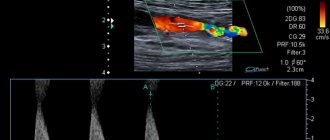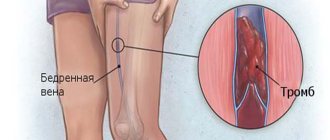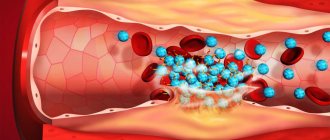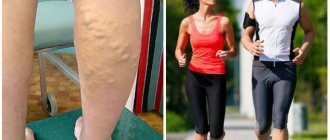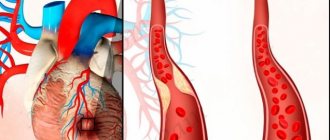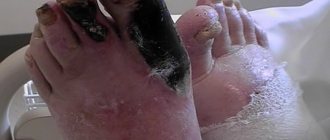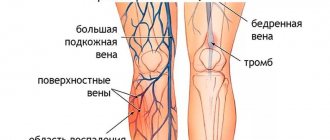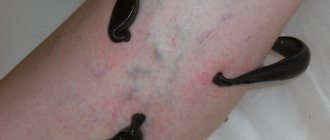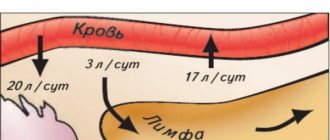Currently, vascular pathologies are diagnosed very often. At the same time, they often pose a threat not only to health, but also to human life. One of these ailments is inflammation of the veins - phlebitis. The course of the pathological process is accompanied by damage to the walls of blood vessels, which sooner or later leads to their destruction. Most often, inflammation of the vein in the leg is detected. How to relieve vein inflammation, what are the causes of this condition - information about this should be provided by a doctor based on medical history and the results of diagnostic measures.
Pathogenesis
Normally, the walls of blood vessels should be elastic, allow the required amount of liquid connective tissue to pass through, and they should not have atherosclerotic plaques, indicating a high concentration of “bad” cholesterol in the body.
Under the influence of any provoking factors in the tissues, the development of the inflammatory process begins. At this time, the person begins to feel severe pain and tension in the vein area.
Phlebitis can be both acute and chronic. Information on how to relieve inflammation of the veins in the leg should only be provided by a doctor. This is due to the fact that discomfort does not arise independently; it is always a consequence of some illness or mechanical damage to blood vessels. In other words, it is first necessary to establish the cause.
Symptoms
The onset of inflammation of the veins can be judged by pain in the legs. At the initial stage, it is short-term, usually towards the end of the day after prolonged work. Patients often mistake it simply for a sign of fatigue. The pain may be accompanied by swelling of the legs in the evening or in the morning.
Signs of superficial phlebitis
Due to the close proximity of the superficial veins, signs of inflammation are clearly visible:
- the appearance of pigmentation at the site of the lesion, the spots resemble red-brown bruises;
- the veins are hard to the touch, often protrude on the surface of the skin, the pulsation is clearly palpable;
- in places of inflammation - a noticeable increase in skin temperature, itching, soreness;
- the appearance of a “web” along the vein.
In the acute form of the disease, a rise in temperature, lethargy and dizziness are observed. When the form is advanced, ulcers and wounds may appear on the skin.
Chronic phlebitis of superficial vessels has the same symptoms, but in a blurred form. Symptoms appear during exacerbations, in a state of remission - patients complain of fatigue, heaviness in the legs, low-grade fever (just over 37°).
Signs of deep vein phlebitis
Phlebitis, in which the deep veins are affected, is characterized by constant heaviness in the legs and swelling of the limbs. If the inflammation affects only one leg, it is noticeably different from the second.
The patient's temperature rises to 37-38°; if treatment is not started, it can last for several months.
The skin on the legs becomes bluish or pale. There is constant pain in the legs, which intensifies with physical activity. Often inflammation of the deep veins is accompanied by the formation of blood clots and thrombophlebitis. Induration and ulceration appear.
Attention. Dangerous consequences of this disease can be heart attack and stroke or pulmonary embolism.
Etiology
Most often, phlebitis is a consequence of varicose veins and infection of the blood vessel wall.
Other reasons for the development of the inflammatory process:
- Violation of the integrity of the skin. Through wounds, tissues often become infected with streptococcus.
- Vein puncture.
- Collection of biological material from a vessel.
- Intravenous injections.
- Burns.
- Entry of an allergen into the body.
- Excess body weight.
- A lifestyle that does not involve physical activity.
- Various types of injuries requiring limb immobilization.
- Long-term bed rest.
- Regular high-intensity physical activity.
In addition, women during pregnancy often complain that a vein in the leg has become inflamed. The doctor should tell you what to do, since taking most medications is contraindicated during the gestational period. But this condition cannot be ignored. Although it is associated with a natural increase in blood volume, it can lead to irreversible consequences.
Why do veins become inflamed?
Phlebitis of the lower extremities occurs for the following reasons:
- pregnancy;
- excess weight;
- limited mobility;
- phlebeurysm;
- prolonged bed rest;
- long exposure to the sun (provokes venous stagnation);
- leg injuries;
- immobilization (ensuring immobility) for fractures, bruises;
- playing sports with heavy loads on the legs.
Post-infusion or post-injection phlebitis most often affects the upper extremities. Pathology is provoked by the following factors:
- long-term presence of an injection catheter in the vessel;
- infection (streptococcus) due to violation of sanitary standards;
- administration of drugs that irritate vascular walls and cause chemical burns;
- treatment of varicose veins using sclerotherapy;
- administering medications through an IV at high speed.
The causes of phlebitis can be:
- hereditary factors;
- infectious diseases;
- smoking, drinking alcohol;
- high blood viscosity;
- weak immunity;
- action of allergens;
- squeezing pimples (phlebitis of the facial vein);
- blood clotting disorder;
- organ injury;
- insect bites;
- side effects of medications;
- obesity;
- diabetes;
- elderly age.
Clinical manifestations
Both superficial and deep veins can be involved in the pathological process. In the first case, a person experiences the following symptoms:
Some patients experience severe weakness, and dizziness often occurs.
This applies if the vessel is located deep. Signs of inflammation of the veins in the legs in this case:
It is not difficult to distinguish between inflammation of superficial and deep veins. In the first case, the skin thickens and turns red, in the second, on the contrary, it becomes pale.
Classification of pathology
In medicine, there are acute and chronic phases of the disease, damage to the superficial and deep veins. Classification of pathology by localization on the wall:
- Periphlebitis. Occurs when inflammation spreads from neighboring tissues. The outer wall of the veins is affected.
- Endophlebitis. The cause of the pathology is trauma to the vessel or the result of a long stay of the needle in the vein during infusion of drugs. The inner wall is damaged.
- Panphlebitis - all vascular membranes are affected.
Taking into account the etiology, the following types of phlebitis are distinguished:
- Allergic. Occurs under the influence of allergens.
- Painful. Characterizes an acute course. It begins in the lower extremities after childbirth and is characterized by severe pain.
- Cerebral. The cause is inflammation that affects the blood vessels of the brain.
- Penis. It is provoked by varicose veins, sexually transmitted infections, and is accompanied by tissue compaction and swelling.
Classification of the disease by etiology includes the following types of phlebitis:
- Migratory. It has a long course with relapses. The arteries and superficial vessels of the lower and upper extremities become inflamed.
- Pylephlebitis is a lesion of the collar vein. Appears as a complication of abdominal pathologies (cholecystitis, appendicitis).
- Infectious. Caused by the action of pathogenic microorganisms. Occurs anywhere in the body.
Diagnostics
It is necessary to contact a phlebologist as soon as possible if a vein in your leg becomes inflamed. How to treat the disease, what is the reason for its development, whether complications can be avoided - the doctor will answer all these questions during the appointment.
The primary diagnosis of phlebitis consists of analyzing the medical history and physical examination. The specialist must provide information regarding all existing symptoms and their intensity, as well as tell whether there have been medical procedures in the recent past (blood sampling, biopsy, etc.).
Diagnosis of inflammation of the veins in the legs involves the following studies:
If complications are suspected, phleboscintigraphy or CT phlebography with the introduction of a contrast agent may be prescribed.
What can be the complications of phlebitis?
In the absence of timely treatment, the main complication is the development of thrombophlebitis - a pronounced inflammatory process of the venous wall with the formation of a blood clot. Phlebitis can cause the formation of long-healing ulcers and infectious processes. In addition, the disease tends to provoke acute purulent inflammation with subsequent intoxication of the body.
Complications of phlebitis: ulcer
Treatment
All activities are usually carried out on an outpatient basis. In severe cases, hospitalization in a hospital is indicated.
The drug therapy regimen includes the following points:
Physiotherapeutic procedures (acupuncture, mud baths, infrared irradiation, etc.) are often included in the treatment regimen for inflammation of the veins in the leg. The patient must also stop smoking and drinking alcohol.
Treatment of phlebitis
Therapy tactics are chosen taking into account the location of inflammation. Phlebitis of deep veins requires hospitalization. Treatment includes the following methods:
- providing rest to the legs;
- tying the limbs with an elastic bandage;
- drug therapy for internal use;
- applying iodine mesh to the affected area;
- compresses, ointments, gels for local treatment;
- physiotherapy;
- quitting smoking, alcohol;
- hirudotherapy;
- wearing compression stockings.
In the absence of results of conservative therapy, the condition is serious, surgical intervention is used using the following methods:
- laser treatment - a catheter is inserted into the vessel, the laser beam acts on the vessel, stopping inflammation;
- thrombectomy (removal of a blood clot through a small incision);
- sclerotherapy is the introduction of special drugs that glue the affected vessel together.
Effective surgical treatment methods:
- phlebectomy (removal of part of the inflamed vein);
- installation of a venous filter - a trap is inserted into the vessel to hold the clot and allow blood to pass through;
- bypass - creating a bypass path past the affected area of the vein to ensure normal blood flow.
Drug therapy
To treat phlebitis, the following types of medications are prescribed:
- Augmentin, Amoxicillin - antibiotics for bacterial causes of the disease;
- Ibuprofen, Ketonal - anti-inflammatory, reduce pain, swelling of the extremities;
- Curantil, Actovegin - improve blood microcirculation;
- Loratadine, Suprastin - antihistamines, eliminate swelling and itching;
- Heparin ointment (prevents blood clots), Voltaren (anti-inflammatory gel) - for local treatment.
The treatment regimen involves the use of the following medications:
- Cardiomagnyl, Aspirin - anticoagulants, thin the blood, prevent thrombosis;
- Detralex, Aescusan - phlebotonics, activate blood flow, eliminate venous congestion;
- Metaliselium lyophilisate, Urokinase - fibrinolytics, promote the dissolution of blood clots;
- Warfarex, Phenilin - reduce prothrombin levels (reduce blood clotting time).
Physiotherapeutic procedures
The following treatment methods help eliminate inflammation during phlebitis, activate blood circulation, improve metabolic processes, reduce pain and swelling:
- acupuncture – increases muscle tone of the vein walls;
- laser exposure – relieves pain, improves blood supply to tissues;
- Magnetic therapy – activates blood flow, strengthens the walls of blood vessels;
- mud wraps – relieve pain.
Effective physiotherapeutic procedures for venous pathologies:
- infrared irradiation - the action of long waves of light anesthetizes, increases local immunity;
- phototherapy – irradiation with a Sollux lamp reduces inflammation;
- therapeutic baths (radon) – promote vasodilation.
Treatment at home: rubbing
Even at the very beginning of the development of the pathological process, a person’s quality of life deteriorates significantly. All he cares about is how to relieve the pain of an inflamed vein in his leg. It is important to know that the use of alternative medicine is acceptable, but they cannot be considered as the main method of treatment. Traditional methods help relieve pain, but do not eliminate the root cause of the development of pathology.
Rubbing is effective for phlebitis. The most effective are the following recipes:
These remedies, according to reviews, are extremely effective if a vein in the leg is inflamed. How to treat an illness at home if signs of an undesirable reaction occur? It is important to remember that all medicinal plants are potential allergens. If alarming signs appear, treatment must be completed or another method must be chosen.
Phlebitis and its varieties
The types of phlebitis are usually divided according to the localization of the inflammatory process; in phlebology there are the following varieties:
- Periphlebitis . Characterized by inflammation of the tissue that surrounds the vein. Develops during the spread of the inflammatory process from the upper layers of tissue.
- Endophlebitis . Is an inflammation of the inner surface of the vein. It occurs as a result of damage to a blood vessel during incorrect injection or prolonged exposure of the needle, for example, when administering drugs by drip.
- Panphlebitis . With this type of phlebitis, all membranes of the vein are affected.
In addition, phlebitis is classified depending on its etiological features:
- Allergic form . The mildest form of phlebitis occurs as a response of the body to an allergen. It responds quite well to treatment with antihistamines.
- Painful form . In most cases, it develops after childbirth. Painful phlebitis is prone to acute progression. Occurs with severe pain.
- Migratory form . A relatively common condition in young men, it can affect any vein, but most commonly occurs in the venous system of the lower extremities. The course of the pathology is long with periods of exacerbation and remission.
Compresses
The disease requires an integrated approach to treatment. It is recommended to alternate rubbing with compresses, and the latter can be done at night. This will allow you to achieve maximum therapeutic effect.
If a vein in the leg is inflamed, how to treat the disease at home using compresses is described below:
The minimum duration of compress application is 30 minutes. But it is better to carry out the procedure at night.
Mechanism of inflammation development
Phlebitis is accompanied by an inflammatory process that affects the vascular endothelium, impaired microcirculation and tissue trophism. As a result of the body's adaptive reaction to the influx of irritants, exudate is formed, which consists of a protein-rich liquid.
With increased permeability of the vascular wall, exudate enters the adjacent tissues, forming edema . Also, as a result of inflammation, tissue proliferation is observed - controlled cell division aimed at compensating for damage. In order for proliferation to occur, the functioning of inflammatory mediators is necessary.
Mediators increase the permeability of vascular walls and ensure the release of exudate containing eosinophils that fight inflammatory agents. Mediators also ensure the activity of platelets and fibroblasts to form a clot that can cover the damaged wall. Substances that are released in the body in response to inflammation “turn on” local cellular immunity and activate the body’s immune systems.
There are different types of classification of phlebitis according to different clinical and morphological characteristics.
Decoctions and infusions for oral use
Simultaneously with local treatment, you can take medicinal agents orally. If a vein in your leg becomes inflamed, what to do:
It is important to remember that any medicinal plant is a potential allergen. Often, while taking decoctions and infusions, an allergic reaction occurs. If alarming signs appear, treatment of phlebitis with folk remedies must be completed.
Methods for diagnosing venous inflammation
The main diagnostic method, in addition to laboratory blood tests, is hardware testing:
OUR READERS RECOMMEND!
To quickly and effectively get rid of varicose veins, our readers recommend the
VARIUS
.
The product eliminates varicose veins in one course, quickly and effectively, and consists only of natural ingredients. VARIUS is completely safe. The product has no side effects. Doctors' opinion...
- Ultrasound of leg veins;
- Duplex scanning.
As a result of a blood test, the number of leukocytes, eosinophils, and platelets is noted. Ultrasound + duplex scanning allows not only to assess the condition of the vascular wall and adjacent tissues, but also to calculate hemocirculation parameters. Unlike MRI, the ultrasound examination method combined with Doppler sonography does not have any radiation effects on the patient’s body. Since it is based on the synthesis of ultrasonic waves by the device, reflected from the structural elements of the blood and the walls of the vessel.
The reflected signal is captured by special sensors and recorded in the form of a color planar image. The affected areas of the veins are highlighted in color in the picture. This method has no contraindications and is used for scanning newborns and pregnant women.
A comprehensive and adequate diagnosis carried out in the early stages of the disease allows us to develop an individual treatment program.
Possible complications
If a vein in your leg is inflamed, what you cannot do is self-medicate. It must be remembered that all medications must be prescribed by a doctor, and traditional methods are intended only to make you feel better, but they will not get rid of the root cause of the disease.
Ignoring pathology is also unacceptable. This can lead to the following pathologies:
Thus, if a vein in the leg becomes inflamed, a specialist should indicate what to do. This is the only way to avoid the development of complications.
What is phlebitis
Vascular pathologies occur in 35-60% of people of working age; after 50 years, they are observed in women twice as often as in men.
Phlebitis is an inflammation of the walls of the veins, occurring in acute and chronic forms. Pathology is possible in all parts of the body, the lower extremities are more affected.
The mechanism of development of pathology is as follows:
- Pathogenic microorganisms penetrate through the vascular walls containing lymphatic ducts from neighboring infected tissues.
- Inflammation begins, covering the veins.
- The structure of blood vessels is disrupted.
- Blood flow slows down, blood clotting increases.
- Blood clots may occur.
Why is inflammation of the venous wall dangerous?
Without treatment, a severe form of the disease is life-threatening. The first danger is thrombosis. Due to accelerated blood clotting, clots appear that block the blood vessels. A detached blood clot causes serious consequences:
- vascular insufficiency;
- pulmonary embolism;
- heart attack;
- stroke;
- leg ulcers.
With diseases of the venous walls, the following complications are possible:
- abscesses and phlegmon with a bacterial cause of pathology;
- thrombophlebitis (inflammation of a vessel near a blood clot);
- venous insufficiency in the chronic stage;
- inflammation in neighboring tissues.
Classification
There are three classes of phlebitis, which differ in the location of the source of inflammation.
- Panphlebitis is a disease in which both the internal and external parts of the vein are susceptible to inflammation.
- Endophlebitis is a focal inflammation of the internal sections of the veins. The main cause of endophlebitis is mechanical damage to the vein, through the insertion of a needle and the patient’s frequent stay on IVs.
- Periphlebitis is damage to the outer sections of the vein. The cause of periphlebitis is inflammation of the tissues surrounding the vessel, as a result of which the outer lining of adjacent veins is damaged.
Folk remedies for vein health
From time immemorial, people have been using folk remedies against venous inflammation; such treatment is quite appropriate and useful. The main components are infusions and decoctions of medicinal herbs, vegetables and fruits. To enhance the effect, medications are often used along with folk remedies: tablets, ointments. Methods suitable for getting rid of inflammation of the veins in the legs:
- compresses;
- rubbing;
- baths;
- ointments;
- use of essential oils;
- drinking juices and decoctions.
Compresses:
- There are many known recipes. For example, a bandage soaked in apple cider vinegar is wrapped around the inflamed areas of the veins twice a day, worn for 30 minutes. The use of apple cider vinegar is considered an effective way to treat venous inflammation. This is due to the high content of various trace elements in vinegar. The treatment will be effective if you use a 100% natural product.
- Recipe with male fern - turn the fresh top of the plant into puree, mix a tablespoon of the mixture with 1 tablespoon of sour milk. Wipe your feet with the prepared mixture.
- Inflammation of the veins in the legs is treated with burdock and Vishnevsky ointment. The veins are lubricated with ointment, fresh washed burdock leaves are applied. The compress is fixed on the legs with bandages or stockings and worn for 3 days.
- White cabbage shows good results. Mash fresh leaves in your hands, or use a rolling pin. On one side, the sheet is smeared with vegetable or olive oil and fixed on the legs for a day. Treatment with this method should last for 1 month.
- Alternative methods include treating the diseased veins with slices of ripe tomato. You can go to bed with such a compress or apply it during the day for 3 hours.
Ripe tomatoes - A popular recipe for a compress with field herbs: mix 2 tbsp. spoons of dry plants: St. John's wort, chamomile flowers, calendula, 1 tbsp. a spoonful of horsetail, tricolor violet and yarrow. Leave a tablespoon of the mixture in boiling water for half an hour, then filter. In the finished infusion, moisten bandages or gauze and fix on the calves.
- Compresses with a solution of bodyaga are considered proven folk remedies. Prepare an infusion - 2 tbsp. spoons of bodyaga pour 1 cup of boiling water for an hour. Bandage swollen veins with soaked bandages and gauze.
- They recommend a proven remedy - the lungs of a freshly slaughtered pig. Finely chop the organ, place it in a layer on cloth or gauze, sprinkle with pharmaceutical sulfur powder and apply compresses to inflammation on the legs.
- Viburnum berries have an anti-inflammatory effect and are used to fight disease. For a compress, crush the berries into puree, then place them on gauze or a cloth and apply them to the veins on the legs. Secure with a bandage and leave overnight. It is allowed to be treated using the described method every evening, alternating with other recipes.
Symptoms
First of all, it is necessary to emphasize that sometimes phlebitis is completely asymptomatic and is discovered by chance .
As for the general symptoms of the disease, the following signs should be noted :
Persistent pain in the ankles High sensitivity of the area Increased temperature in the area Acceleration of heart rate High temperature
The time has come to note the specific symptoms of superficial and deep phlebitis.
Symptoms of superficial phlebitis
High temperature Pain that increases with pressure on the area Increased volume of veins Swelling Redness
Symptoms of deep phlebitis
Fever Rapid heartbeat Severe pain in the arm, leg or shoulder (depending on the area where the disease develops) Yellowish skin tone Inflammation and swelling In some cases, gangrene may develop in the veins
Disease prevention
It is easier to prevent a disease than to spend a long time treating it. The following measures can be recommended as preventive measures:
- Women taking birth control pills should have their blood clotting tested periodically.
- It is useful to give your legs a rest while lying down, placing them on a pillow or on the back of the sofa.
- People whose professional activities involve constant standing are recommended to wear compression stockings.
- You can take Aspirin as a thinning agent, but this should only be done with the permission of a doctor.
- Walk more and devote time to physical activity.
- Treat any infectious diseases promptly.
- If you have varicose veins, follow all doctor's recommendations.
- If you already have phlebitis, then it is advisable to quit smoking.
If you take good care of your health, you won’t have to go to the doctor and treat vein diseases. Take care of yourself and be healthy!
Disease prevention
Since phlebitis is most often diagnosed in people with varicose veins, patients are recommended to be periodically examined in the hospital. As a preventive measure it is also recommended:
- completely stop drinking alcoholic beverages and tobacco products;
- play sports, lead an active lifestyle;
- go to the hospital if you receive limb injuries;
- limit the intake of drugs that negatively affect the vascular walls (for example, anti-conception drugs have this property);
- take blood thinners;
- strengthen the immune system;
- undergo periodic examinations by phlebologists.
Peculiarities! It is difficult to independently notice the development of a chronic form of the disease. Periodic medical examinations will make it possible to identify the problem before it enters the acute phase.
PHLEBITIS: 5 natural remedies for treatment
Phlebitis can be a very dangerous phenomenon if appropriate measures are not taken in time. So be attentive to your health, this will help you avoid possible complications.
Phlebitis is a pathology that disrupts normal blood circulation. To treat phlebitis, you can choose completely natural remedies. Unfortunately, phlebitis can cause serious health consequences. But just like any other disease, it can be prevented by maintaining an active and healthy lifestyle.
Features of development, causes and risk factors
Phlebitis is the development of an inflammatory process in the walls of the superficial veins of the lower extremities. This pathology is common and acts as a complication of varicose veins. The disease is divided into acute and chronic forms, each of which causes pain and suffering to the patient.
If phlebitis is not treated, it leads to destruction of the walls of blood vessels.
Often the disease is provoked by infections, damage by harmful microbes or pathogenic organisms. The disease often occurs with the formation of blood clots, which are very dangerous - a severed blood clot clogs an important blood vessel, which leads to the death of the patient.
Prerequisites for the development of the disease include:
- Infection is the main reason. Here, streptococcus is one of the main pathogens.
- Damage to the vessel - occurs during intramuscular injection or when installing a catheter.
- Chemical exposure is a chemical burn that occurs as a result of the administration of a medicinal product.
- Inflammatory process in tissues adjacent to the vessel - boils or abscess.
- Varicose veins - dilated and inflamed vessels are the main cause of phlebitis.
If varicose veins are not treated, they lead to the development of thrombophlebitis and even trophic ulcers on the legs.
At risk of developing phlebitis are mainly people with varicose veins - pathological enlargement of veins due to the loss of the former elasticity of the walls of the circulatory system. Risk factors for this disease are:
- excess weight – there is a large load on the legs and vascular system;
- inactivity;
- long fixed vertical position;
- long periods of standing;
- the occurrence of allergic manifestations;
- long hospital treatment with intravenous injections.
Despite the cause of the disease, it cannot be left untreated, because it is fraught with serious complications. You must immediately go to an appointment with a phlebologist so that he can conduct an appropriate examination and prescribe treatment.
Types of pathology
The pathology under consideration is divided into types depending on the location and etiology. Classification according to the location of the lesion is as follows:
- Periphlebitis - inflammation of the outer lining of the walls of blood vessels occurs. Occurs due to “infection” from neighboring tissues.
- Endophlebitis – characterizes inflammation of the inner wall of a vessel. Development begins with the installation of a catheter and the long stay of the catheter in the vein. Often it begins to form as a result of incorrect administration of a hypertonic drug into a vein.
- Panphlebitis - all layers of the vessel are affected.
Types of phlebitis, taking into account the origin of the disease:
- Allergic. It appears as a result of allergies and lasts a very long time, often becoming chronic.
- Painful. Diagnosed after the birth of the child. It has an acute form with severe pain and manifestations of all symptoms.
- Migratory. Occurs mainly in men. Phlebitis of the superficial veins develops and affects the arteries. The disease lasts a long time with periodic exacerbations.
- Cerebral. Blood vessels in the brain are affected. They have an infectious cause.
- Pylephlebitis. Localized in the collar vein. Develops against the background of an inflammatory disease in the abdominal cavity.
- Infectious. It is diagnosed not only in the lower extremities, but anywhere in the human body.
It is necessary to find out exactly what kind of phlebitis affected the patient’s legs. The symptoms and treatment of different types of disease differ from each other and it is impossible to figure it out without a doctor.
Symptoms and diagnosis
Having different types, phlebitis also differs in the manifestations of the disease. Common signs are pain and the formation of red stripes along the diseased vein. Symptoms depending on the type of pathology:
- A disease affecting the surfaces of blood vessels. It is characterized by tension and soreness of the veins, taking into account the development of the acute form. The skin in the affected area becomes dense, swollen, has redness, increased temperature, and is noticeable to the touch. With further development, body temperature rises.
- Chronic form of the disease. There are no obvious symptoms. This becomes noticeable during the period of exacerbation.
- A disease affecting the deep veins. The skin in the affected areas becomes milky white, swollen and painful. This form of the disease is dangerous due to its transition to thrombophlebitis with the formation of blood clots in the vessels - thrombi.
- Cerebral phlebitis. The patient is bothered by constant headaches and neurological lesions, accompanied by increased blood pressure.
- Phlebitis of the collar vein. Leads to purulent intoxication, after which the patient vomits, weakness, pain and cutting sensations develop in the right side under the ribs, and jaundice is often diagnosed. Chills and fever occur with profuse sweating.
When the disease worsens, a person is concerned about general weakness and an increase in body temperature. If the deep veins are inflamed, then severe pain appears when walking for a long time or wearing uncomfortable shoes in the evening.
If the presented symptoms of phlebitis occur, the patient should immediately contact a vascular surgeon for a diagnosis and proper treatment of the pathology. Diagnosis begins with an external examination of the patient.
Then he is prescribed a vascular ultrasound to determine the location of the source of the disease and its severity, and a bacteriological blood culture study is also carried out to determine the nature of the pathogen and its sensitivity to drugs. In difficult cases, imaging examinations with the introduction of a contrast agent are prescribed, if such a method can be used.
Conservative treatment
We have already studied a little phlebitis of the lower extremities, symptoms and treatment. The photo demonstrates that the first step in therapy begins with taking medications.
- If you have an infectious disease, you cannot do without taking antibacterial agents. This can be either by injection or by taking tablets.
- Doctors are confident that treatment is required if there is phlebitis of the lower extremities. Tablets to improve the tone of the walls of blood vessels are prescribed first. Such drugs include: Detralex, Phlebodia, Escusan and others.
- It is necessary to take anti-inflammatory drugs that will help remove inflammation. Such medications can be used in the form of ointments and gels, for example, Ketonal, Fastum-gel, Movalis, Voltaren. They not only eliminate the inflammatory process, but also relieve fever and prevent tissue swelling.
- Experts also prescribe taking medications to improve tissue regeneration and repair, and vitamin preparations. These include Wobenzym, Actovegin, Solcoseryl.
- Taking anticoagulants will prevent the formation of blood clots in the vessels. “Heparin”, “Fraxiparin”, “Curantil” cope well with this.
After such drug therapy, phlebitis of the lower extremities does not manifest itself so clearly. Symptoms and treatment (the photo below demonstrates one of the methods) can be supplemented with physiotherapeutic procedures. Most often, the doctor prescribes the following:
- UHF or infrared radiation.
- Darsonvalization.
- Diadynamic currents.
- Hirudotherapy.
- Sollux.
If you combine physiotherapy with drug therapy, you can significantly improve the condition of the venous vessels.
Surgery
We looked at how to treat phlebitis of the lower extremities at home, but, unfortunately, such therapy does not always give the desired results, especially if the patient neglects the advice of specialists. In some cases, the disease easily turns into thrombophlebitis, and this is much more dangerous to health. Doctors use:
- Vein ligation.
- Dissection of the vein in the place where the blood clot has formed.
- The inflamed section of the vein is removed.
Even after surgical treatment, you should not think that the disease has been defeated once and for all. If you do not take care of your feet, neglect your own health and do not follow the recommendations of doctors, the disease will quickly return with renewed vigor.
How to prevent complications
Following the rules for preventing varicose veins on the legs and massaging the limbs after a hard day at work is the key to avoiding the disease, even in the presence of the negative factors mentioned above. However, what to do if the veins are already dilated and there is a danger of worsening the condition of the legs?
Allergy pills are the most effective broad-spectrum medications. The best manufacturers and characteristics of optimal anti-allergenic productsPrevention of infectious skin diseases
Wen on the body - the reasons for its appearance and who to contact with the problem. 130 photos and videos of treatment and removal of wen
In such cases, of course, it is necessary to take all the medications prescribed by the doctor, but at the same time try to help yourself.
To do this you should:
- quit bad habits (smoking, alcohol abuse);
- instead of sweets and fatty foods, introduce more fruits and vegetables into your diet;
- if possible, go swimming;
- learn to look at the world positively and not be nervous about little things.
What treatment is prohibited for phlebitis?
Most patients think that if they have problems with veins in their legs, wearing compression stockings is enough. But for phlebitis of the lower extremities, such therapy is strictly contraindicated. If there is an inflammatory process, then free outflow of fluid from the source of inflammation is necessary, and compression hosiery can provoke the release of fluid into the lumen of the venous vessel and accelerate blood flow. But in the presence of a streptococcal infection, this can lead to the spread of the pathogen throughout the body.
After the inflammation has been eliminated, which must be confirmed by tests, compression hosiery can be used, but you should start with a minimum degree of compression.
Causes of phlebitis
There are certain reasons that cause vascular disease such as phlebitis . This:
- Pregnancy
- Varicose veins
- Erysipelas
- Phlegmon
- Oncological diseases
- Tuberculosis
- Wound infection
- Insect bites
- Suppuration, complication of abscess
- Chemical burn of a vein
- Impaired lymph flow, removal of lymph nodes
- Sclerotherapy
- Long-term use of an intravenous catheter
- Forced immobility or sedentary lifestyle
- Excess weight
- Injuries, frequent vein damage
- Reaction to injections
Reasons for the development of phlebitis
Doctors consider varicose veins to be the main cause of phlebitis. In addition, we can name a number of other factors that can provoke the development of pathology:
- Excess weight: this puts even more strain on the veins.
- Low physical activity: it has become the scourge of the 21st century.
- Prolonged vertical position, for example, store clerks are forced to stand behind the counter all day.
- Abnormal bowel movements, for example constipation.
In some cases, allergic reactions can also trigger the development of the disease.
Much less often, the development of phlebitis is caused by injury to a vein or its damage as a result of the development of an infectious disease.
No matter what the cause of the disease is, it cannot be left without treatment, so as not to develop serious complications.
